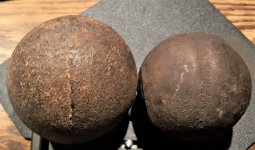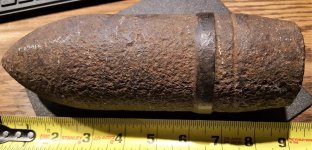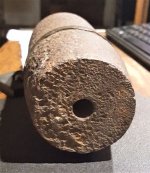- Mar 5, 2010
- 7,590
- 12,148
- Detector(s) used
- XP Deus, White's DFX
- Primary Interest:
- All Treasure Hunting
I purchased my brothers collection a few years ago but let him keep it with the understanding that if something happened to him first I would get it and if I passed before him he would keep it. Sadly, I took possession of what relics he had left and now will need help with some of them.
I will start with three projectiles. The larger of the two round balls is 3.5" in diameter and weighs 5lb 14oz on my postal scales. The smaller ball is 3" and weighs 4lb 3oz. Both balls have a seam in them. In the picture the seam is running vertically on both pieces. The seam is harder to see on the 3.5" ball but it is there.
The shell is about 9"s long, 3" in diameter and weighs 13.6lbs on my bathroom scales. I don't have a scale to accurately measure its weight. I am pretty sure the large ball and the shell are projectiles but the small ball I question.
Any help in IDing them with there correct names is much appreciated.
I will start with three projectiles. The larger of the two round balls is 3.5" in diameter and weighs 5lb 14oz on my postal scales. The smaller ball is 3" and weighs 4lb 3oz. Both balls have a seam in them. In the picture the seam is running vertically on both pieces. The seam is harder to see on the 3.5" ball but it is there.
The shell is about 9"s long, 3" in diameter and weighs 13.6lbs on my bathroom scales. I don't have a scale to accurately measure its weight. I am pretty sure the large ball and the shell are projectiles but the small ball I question.
Any help in IDing them with there correct names is much appreciated.












